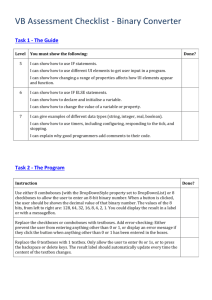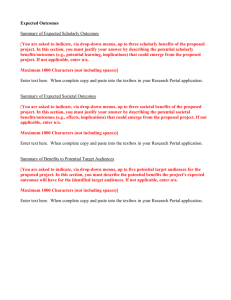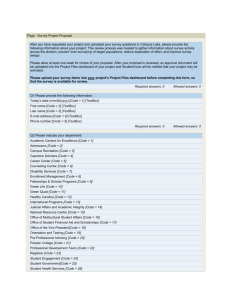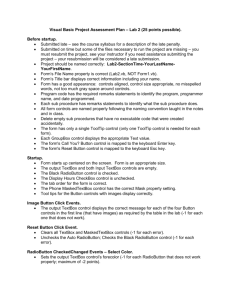Practical 2 - BIDD - National University of Singapore
advertisement
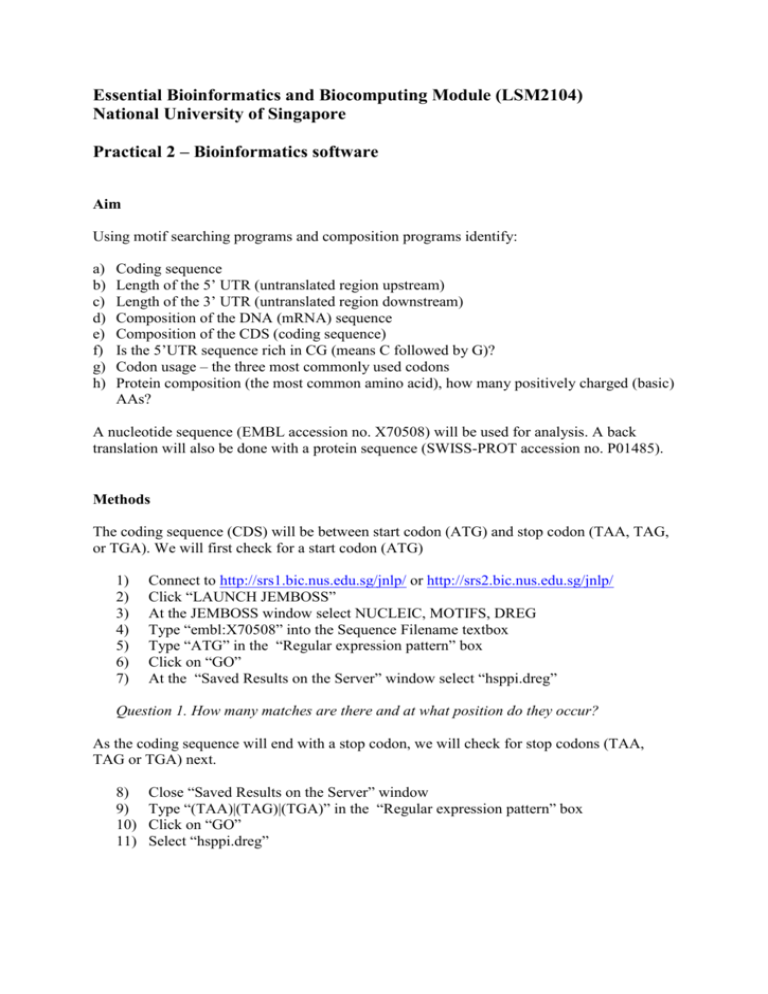
Essential Bioinformatics and Biocomputing Module (LSM2104) National University of Singapore Practical 2 – Bioinformatics software Aim Using motif searching programs and composition programs identify: a) b) c) d) e) f) g) h) Coding sequence Length of the 5’ UTR (untranslated region upstream) Length of the 3’ UTR (untranslated region downstream) Composition of the DNA (mRNA) sequence Composition of the CDS (coding sequence) Is the 5’UTR sequence rich in CG (means C followed by G)? Codon usage – the three most commonly used codons Protein composition (the most common amino acid), how many positively charged (basic) AAs? A nucleotide sequence (EMBL accession no. X70508) will be used for analysis. A back translation will also be done with a protein sequence (SWISS-PROT accession no. P01485). Methods The coding sequence (CDS) will be between start codon (ATG) and stop codon (TAA, TAG, or TGA). We will first check for a start codon (ATG) 1) 2) 3) 4) 5) 6) 7) Connect to http://srs1.bic.nus.edu.sg/jnlp/ or http://srs2.bic.nus.edu.sg/jnlp/ Click “LAUNCH JEMBOSS” At the JEMBOSS window select NUCLEIC, MOTIFS, DREG Type “embl:X70508” into the Sequence Filename textbox Type “ATG” in the “Regular expression pattern” box Click on “GO” At the “Saved Results on the Server” window select “hsppi.dreg” Question 1. How many matches are there and at what position do they occur? As the coding sequence will end with a stop codon, we will check for stop codons (TAA, TAG or TGA) next. 8) 9) 10) 11) Close “Saved Results on the Server” window Type “(TAA)|(TAG)|(TGA)” in the “Regular expression pattern” box Click on “GO” Select “hsppi.dreg” Question 2. How many matches are there and at what position do they occur? Next we will do a nucleic acid translation to determine potential open reading frames (ORF). 12) 13) 14) 15) 16) 17) 18) Go to JEMBOSS window Select NUCLEIC, TRANSLATION, TRANSEQ Type “embl:X70508” into the Sequence Filename textbox Click on “Advanced Options” Select “Forward three frames” at the advanced section Click “GO” At the “Saved Results on the Server” window select “hsppi.pep” Question 3. Using the answers from Question 1 and 2 and the nucleic acid translation, determine the most likely coding sequence (CDS). Provide reasons for you choice. (Hint. If you get two possible answers, choose the longer one.) Question 4. Based on your coding sequence, determine the 5’ UTR. Question 5. Based on your coding sequence, determine the 3’ UTR. (Hint. Refer to Appendix B for sequence information.) Next we will determine the composition of the DNA (mRNA). 19) 20) 21) 22) 23) At the JEMBOSS window select NUCLEIC, COMPOSITION, COMPSEQ Type “embl:X70508” into the Sequence Filename textbox Type 1 in the “Word size to consider” box Click “GO” At the “Saved Results on the Server” window select “hsppi.composition” Question 6. What is the composition of the DNA (mRNA)? Next we will determine the composition of the DNA (CDS). 24) 25) 26) 27) 28) 29) 30) 31) At the JEMBOSS window select NUCLEIC, COMPOSITION, COMPSEQ Type “embl:X70508” into the Sequence Filename textbox Click on Input Sequence Options Type in the start of your CDS in the begin textbox Type in the end of your CDS in the end textbox Click “OK” Click “GO” At the “Saved Results on the Server” window select “hsppi.composition” Question 7. What is the composition of the DNA (CDS)? We now determine whether the 5’ UTR is rich in CG (means C followed by G)? 32) 33) 34) 35) 36) 37) 38) 39) 40) At the JEMBOSS window select NUCLEIC, COMPOSITION, COMPSEQ Type “embl:X70508” into the Sequence Filename textbox Click on Input Sequence Options Type in the start of your 5’ UTR in the begin textbox Type in the end of your 5’ UTR in the end textbox Click “OK” Type 2 in the “Word size to consider” box Click “GO” At the “Saved Results on the Server” window select “hsppi.composition” Question 8. Is the 5’ UTR rich in CG? Next we will determine the Codon Usage (usage of the codons – triplets of nucleotides) – the three most commonly used codons. 41) 42) 43) 44) 45) 46) 47) 48) At the JEMBOSS window select NUCLEIC, CODON USAGE, CUSP Type “embl:X70508” into the Sequence Filename textbox Click on Input Sequence Options Type in the start of your CDS in the begin textbox Type in the end of your CDS in the end textbox Click “OK” Click “GO” At the “Saved Results on the Server” window select “hsppi.cusp” Question 9. What are the three most common codons in the CDS? We will now determine the protein composition. To do so we need to first translate the CDS to get the protein sequence. 49) 50) 51) 52) 53) 54) 55) 56) 57) 58) 59) At the JEMBOSS window select NUCLEIC, TRANSLATION, TRANSEQ Type “embl:X70508” into the Sequence Filename textbox Click on Input Sequence Options Type in the start of your CDS in the begin textbox Type in the end of your CDS in the end textbox Click “OK” Click “Advanced options” Select “1” in “Frame(s) to translate” window Click “GO” At the “Saved Results on the Server” window select “hsppi.pep” Select the protein sequence and press “Ctrl+C” to copy the protein sequence Once the protein sequence has been copied, we can determine the protein composition. 60) At the JEMBOSS window select PROTEIN, COMPOSITION, PEPSTATS 61) Select “paste” and paste the protein sequence by doing a double RIGHT click on the empty textbox (if the results is not correct, then you did not do steps 49 to 57 correctly) 62) Click “GO” 63) At the “Saved Results on the Server” window select “outfile.pepstats” Question 10. How many positively charged (basic) AA are there? We will now perform a back translation using a protein sequence of a toxin from a common European scorpion (SWISS-PROT accession no. P01485). 64) 65) 66) 67) At the JEMBOSS window select NUCLEIC, TRANSLATION, BACKTRANSEQ Type “swissprot:P01485” into the Sequence Filename textbox Click “GO” At the “Saved Results on the Server” window select “scx3_butoc.fasta” Question 11. Is this the only possible nucleotide sequence for this protein? (Hint. Use information in Appendix A and B to aid you) Appendix A. Amino acid and codon tables (T in DNA becomes U in RNA) First two positions AA AC AG AU CA CC CG CU GA GC GG GU UA UC UG UU NAME Alanine Cysteine Aspartic Acid Glutamic Acid Phenylalanine Glycine Histidine Isoleucine Lysine Leucine Methionine Asparagine Proline Glutamine Arginine Serine Threonine Valine Tryptophan Tyrosine Stop Codons A Lys Thr Arg Ile Gln Pro Arg Leu Glu Ala Gly Val Stop Ser Stop Leu 3 Letter Ala Cys Asp Glu Phe Gly His Ile Lys Leu Met Asn Pro Gln Arg Ser Thr Val Trp Tyr Stop Third Position C G Asn Lys Thr Thr Ser Arg Ile MET His Gln Pro Pro Arg Arg Leu Leu Asp Glu Ala Ala Gly Gly Val Val Tyr Stop Ser Ser Cys Trp Phe Leu 1 Letter A C D E F G H I K L M N P Q R S T V W Y . or * U Asn Thr Ser Ile His Pro Arg Leu Asp Ala Gly Val Tyr Ser Cys Phe codons for Amino Acids GCA,GCC,GCG,GCU UGC,UGU GAC,GAU GAA,GAG UUC,UUU GGA,GGC,GGG,GGU CAC,CAU AUA,AUC,AUU AAA,AAG UUA,UUG,CUA,CUC,CUG,CUU AUG AAC,AAU CCA,CCC,CCG,CCU CAA,CAG CGA,CGC,CGG,CGU UCA,UCC,UCG,UCU,AGC,AGU ACA,ACC,ACG,ACU GUA,GUC,GUG,GUU UGG UAC,UAU UAA,UAG,UGA Appendix B. Sequences used in this practical Nucleotide sequence (EMBL accession no. X70508) Total number of bases = 450 >X70508|HSPPI Homo sapiens mRNA for insulinoma pre-proinsulin gctgcatcagaagaggccatcaagcacatcactgtccttctgccatggccctgtggatgc gcctcctgcccctgctggcgctgctggccctctggggacctgacccagccgcagcctttg tgaaccaacacctgtgcggctcacacctggtggaagctctctacctagtgtgcggggaac gaggcttcttctacacacccaagacccgccgggaggcagaggacctgcaggtggggcagg tggagctgggcgggggccctggtgcaggcagcctgcagcccttggccctggaggggtccc tgcagaagcgtggcattgtggaacaatgctgtaccagcatctgctccctctaccagctgg agaactactgcaactagacgcagcccgcaggcagccccccacccgccgcctcctgcaccg agagagatggaataaagcccttgaaccagc Protein sequence (SWISS-PROT accession no. P01485) Total number of amino acids = 64 >P01485|SCX3_BUTOC Neurotoxin III. VKDGYIVDDRNCTYFCGRNAYCNEECTKLKGESGYCQWASPYGNACYCYKVPDHVRTKGP GRCN
